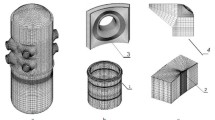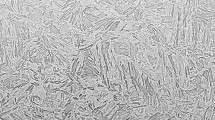Abstract
The concentration of thermal stresses is one of the main factors leading to a decrease in thermal strength under cyclic loading conditions. It is characterized by the stress concentration factor Kt, the value of which can be determined by analytical or numerical methods as well as experimentally. In modern regulatory documents, various values of the thermal stress concentration coefficient are indicated. The results of studies carried out as part of the work on the justification of thermal and cyclic strength are presented. Their comparison with the data of current regulatory documents is given on the example of typical outlet headers of superheaters for heat recovery steam generators of modern combined cycle gas turbines (CCGT). Formulas have been obtained that make it possible to calculate the concentration coefficient in a tee connection according to the known size ratios and parameters of the operating mode and to substantiate the operation modes of heat recovery steam generators. It is shown that taking into account a number of factors that determine the intensity of heat transfer in tee joints leads to a decrease in the concentration coefficients relative to the value of 2.0 currently accepted in some regulatory documents for all heat-transfer modes and ratios of the tee joints' dimensions. Reducing the values of the concentration factor included in the calculation when designing a part makes it possible to reduce metal consumption, lighten the design, and save money on its manufacture.


Similar content being viewed by others
REFERENCES
P. Neuber, Stress Concentration (Gostekhizdat, Moscow, 1947) [in Russian].
R. E. Peterson, Stress Concentration Factors: Charts and Relations Useful in Making Strength Calculations for Machine Parts and Structural Elements (Wiley, New York, 1974; Mir, Moscow, 1977).
CS 27.040. Technische Regeln für Dampfkessel — Berechnung auf Wechselbeanspruchung durch schwellenden Innendruck bzw. durch kombinierte Innendruck- und Temperaturänderung (TRD 301 Anlage 1) (Heymanns, Köln, 1975).
RD 10-249-98. Norms for Strength Calculation of Stationary Boilers and Steam and Hot Water Pipelines (Gosgortekhnadzor Rossii, Moscow, 2004).
DS/EN 12952-3. Water-Tube Boilers and Auxiliary Installations. Part 3: Design and Calculation for Pressure Parts of the Boiler (Standardiseringsrad, Dansk, 2012).
E. R. Plotkin and M. N. Zinger, “Concentration of temperature stresses in the branch pipes of the drums of power-generating boilers,” Therm. Eng. 44, 155–160 (1997).
Author information
Authors and Affiliations
Corresponding author
Rights and permissions
About this article
Cite this article
Plotkin, E.R., Kontorovich, T.S. Analysis of the Thermal Stress Concentration Coefficients in Tee Joints. Therm. Eng. 69, 632–635 (2022). https://doi.org/10.1134/S0040601522080067
Received:
Revised:
Accepted:
Published:
Issue Date:
DOI: https://doi.org/10.1134/S0040601522080067




